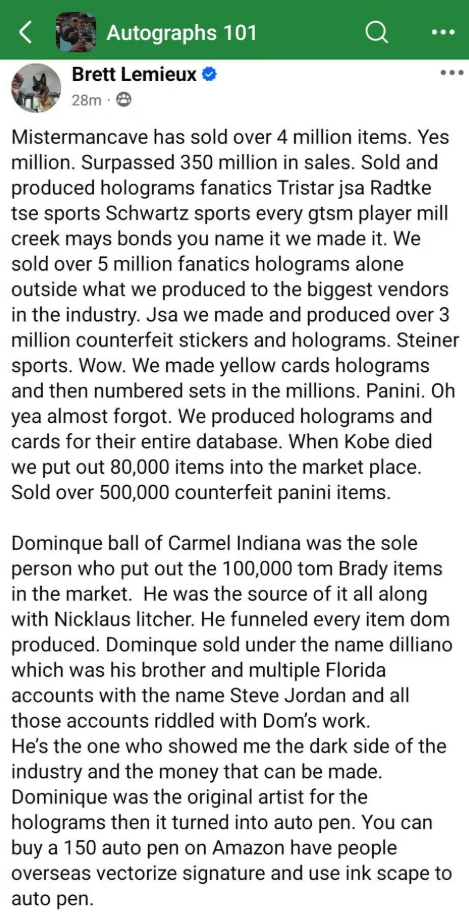In a tale more baffling than an unexpected play at the bottom of the ninth, the pristine realm of sports memorabilia has been shaken to its core. All the action is unfolding in none other than America’s heartland, where a notorious counterfeit operation was uncovered in sleepy Westfield, Indiana. Picture this: already a hub of suburban tranquility, now thrust into controversy, thanks to the secretive dealings of Brett Lemieux. This autograph dealer, whose name once carried weight in collector circles, finds himself posthumously embroiled in a scandal that has collectors clutching their merchandise with skepticism.
Brett Lemieux, who was known for his energetic business ventures under the brand name Mister Mancave, allegedly orchestrated his own swan song—a multifaceted operation involving more than four million fake sports memorabilia items. Initially discovered during a dramatic police raid, his untimely demise—ruled by Westfield authorities as a self-inflicted gunshot wound—marks the climax of a counterfeit saga that has been brewing unbeknownst to the countless collectors across the nation.
The eye of this storm is a troubling confession purportedly penned by Lemieux on “Autographs 101,” a popular Facebook group among hobbyists, where he laid bare the scale of his machinations. According to his post, his operation generated a staggering $350 million in counterfeit sales. Let that sink in—$350 million worth of supposed history and hero-infused items floating through the collectors’ ecosystem like an unstoppable tide that went unseen for too long. Now, sports fans and memorabilia mavens are confronting the chilling reality that their treasures might indeed be fool’s gold.
Operating from what he claimed was “the largest framed jersey inventory on the web,” Lemieux’s storefront supposedly sprouted in Columbus, Ohio, yet, finding any tangible trace of such a store proved as elusive as a pristine rookie card from the ’52 Topps set. His business maneuvers left tracks in Indiana’s incorporation records twice between 2018 and 2023, threading yet more complexity into this unfolding drama.
The last lap of Lemieux’s journey as relayed in his own words before his passing was how meticulously his operation counterfeited the much-trusted hologram stickers used by legitimate authentication powerhouses such as Panini, Fanatics, and James Spence Authentics. He detailed how, following the tragic death of legendary basketball icon Kobe Bryant, the market was flooded with approximately 80,000 fraudulent Bryant-related items—each seemingly authentic under the glow of expertly forged holograms.
The items peddled went beyond the hardwood court. Lemieux’s online offerings spanned baseball, football, and beyond, including an Aaron Judge-signed baseball dangled before fans at a tantalizingly reduced price—offered for $399 compared to Fanatics’ official $699 tag. These impressive deals, fortified by counterfeit credentials, masked their reality until now, allowing them to slip past even the eagle-eyed.
The swindle, while contested in monetary magnitude by some in the field—$350 million, many claim, is a mountain too vast to conquer through forgeries alone—has unmistakably planted seeds of doubt. Autograph authentication experts like Steve Grad highlight the increasingly challenging task of differentiating genuine signatures from phantom duplicates, as modern autopens and advanced forgery techniques muddy the waters. The implications of Lemieux’s alleged enterprise promise rippling reverberations in the market for years to come.
Yet as promises of trustworthiness in this niche market take a hit, Fanatics steps forward. A beacon of transparent dealings amidst counterfeit clouds, they announce reinforced anti-counterfeit defenses and deeper collaboration with law enforcement experts, including seasoned FBI veterans, to prevent such masquerades from masquerading as reality in the future.
It appears some insiders harbored suspicions. A few stretching back for years, like dormant seeds awaiting their moment in the sun. Whispers about Lemieux’s dealmaking existed, with competitors raising eyebrows at his wide array of signatures from athletes who had long fallen silent from public signings. Still, until his supposed digital confession, the whispers were mere murmurings overshadowed by the vibrant marketplace buzz.
Also caught in this scandal’s far-reaching web are names Lemieux mentioned as cohorts in his exposé, such as Dominique Ball from Indiana and Wisconsinite Nickolas Litscher. Both have vociferously repudiated any involvement. Litscher, in particular, seems ready to go the distance, preparing legal measures to clear his name from the public shaming online discussions peppered with.
In these moments of controversy and clarity for the hobbyists, the story serves as stark reminder. Authenticity—like the tides—is ever-shifting and requires diligence. Collectors, wise to the deception unveiled, must now adopt sharper scrutiny. The fallout from this scandal could be the catalyst for industry-wide checks and innovation in forgery prevention, potentially ushering in a new era of assurance for everyone clutching a memorabilia piece with the weight of sports history in their grip.





